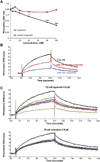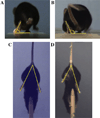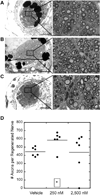Tegaserod mimics the neurostimulatory glycan polysialic acid and promotes nervous system repair
- PMID: 24067923
- PMCID: PMC4618794
- DOI: 10.1016/j.neuropharm.2013.09.014
Tegaserod mimics the neurostimulatory glycan polysialic acid and promotes nervous system repair
Abstract
Glycans attached to the cell surface via proteins or lipids or exposed in the extracellular matrix affect many cellular processes, including neuritogenesis, cell survival and migration, as well as synaptic activity and plasticity. These functions make glycans attractive molecules for stimulating repair of the injured nervous system. Yet, glycans are often difficult to synthesize or isolate and have the disadvantage to be unstable in a complex tissue environment. To circumvent these issues, we have screened a library of small organic compounds to search for structural and functional mimetics of the neurostimulatory glycan polysialic acid (PSA) and identified the 5-HT4 receptor agonist tegaserod as a PSA mimetic. The PSA mimicking activity of tegaserod was shown in cultures of central and peripheral nervous system cells of the mouse and found to be independent of its described function as a serotonin (5-HT4) receptor agonist. In an in vivo model for peripheral nerve regeneration, mice receiving tegaserod at the site of injury showed enhanced recovery compared to control mice receiving vehicle control as evidenced by functional measurements and histology. These data indicate that tegaserod could be repurposed for treatment of nervous system injuries and underscores the potential of using small molecules as mimetics of neurostimulatory glycans.
Keywords: Drug repurposing; Glycan; Mimetic; Peripheral nerve; Polysialic acid; Regeneration; Tegaserod.
Copyright © 2013. Published by Elsevier Ltd.
Conflict of interest statement
The authors declare no conflicts of interest regarding this work.
Figures








Similar articles
-
The polysialic acid mimetics 5-nonyloxytryptamine and vinorelbine facilitate nervous system repair.Sci Rep. 2016 Jun 21;6:26927. doi: 10.1038/srep26927. Sci Rep. 2016. PMID: 27324620 Free PMC article.
-
Tegaserod, a small compound mimetic of polysialic acid, promotes functional recovery after spinal cord injury in mice.Neuroscience. 2014 Sep 26;277:356-66. doi: 10.1016/j.neuroscience.2014.06.069. Epub 2014 Jul 9. Neuroscience. 2014. PMID: 25014876
-
Polysialic acid glycomimetics promote myelination and functional recovery after peripheral nerve injury in mice.Brain. 2009 Jun;132(Pt 6):1449-62. doi: 10.1093/brain/awp128. Epub 2009 May 19. Brain. 2009. PMID: 19454531
-
Sialic acids in the brain: gangliosides and polysialic acid in nervous system development, stability, disease, and regeneration.Physiol Rev. 2014 Apr;94(2):461-518. doi: 10.1152/physrev.00033.2013. Physiol Rev. 2014. PMID: 24692354 Free PMC article. Review.
-
Schwann Cell Role in Selectivity of Nerve Regeneration.Cells. 2020 Sep 20;9(9):2131. doi: 10.3390/cells9092131. Cells. 2020. PMID: 32962230 Free PMC article. Review.
Cited by
-
Small Organic Compounds Mimicking the Effector Domain of Myristoylated Alanine-Rich C-Kinase Substrate Stimulate Female-Specific Neurite Outgrowth.Int J Mol Sci. 2023 Sep 19;24(18):14271. doi: 10.3390/ijms241814271. Int J Mol Sci. 2023. PMID: 37762575 Free PMC article.
-
Neural glycomics: the sweet side of nervous system functions.Cell Mol Life Sci. 2021 Jan;78(1):93-116. doi: 10.1007/s00018-020-03578-9. Epub 2020 Jul 1. Cell Mol Life Sci. 2021. PMID: 32613283 Free PMC article. Review.
-
Antagonistic L1 Adhesion Molecule Mimetic Compounds Inhibit Glioblastoma Cell Migration In Vitro.Biomolecules. 2022 Mar 12;12(3):439. doi: 10.3390/biom12030439. Biomolecules. 2022. PMID: 35327631 Free PMC article.
-
Functions of Small Organic Compounds that Mimic the HNK-1 Glycan.Int J Mol Sci. 2020 Sep 24;21(19):7018. doi: 10.3390/ijms21197018. Int J Mol Sci. 2020. PMID: 32987628 Free PMC article.
-
The polysialic acid mimetics 5-nonyloxytryptamine and vinorelbine facilitate nervous system repair.Sci Rep. 2016 Jun 21;6:26927. doi: 10.1038/srep26927. Sci Rep. 2016. PMID: 27324620 Free PMC article.
References
-
- Angata K, Fukuda M. Roles of polysialic acid in migration and differentiation of neural stem cells. Methods Enzymol. 2010;479:25–36. - PubMed
-
- Berski S, van Bergeijk J, Schwarzer D, Stark Y, Kasper C, Scheper T, Grothe C, Gerardy-Schahn R, Kirschning A, Drager G. Synthesis and biological evaluation of a polysialic acid-based hydrogel as enzymatically degradable scaffold material for tissue engineering. Biomacromolecules. 2008;9:2353–2359. - PubMed
-
- Busti AJ, Murillo JR, Jr, Cryer B. Tegaserod-induced myocardial infarction: case report and hypothesis. Pharmacotherapy. 2004;24:526–531. - PubMed
MeSH terms
Substances
Grants and funding
LinkOut - more resources
Full Text Sources
Other Literature Sources
Research Materials
Miscellaneous

